
Fery - 1-8-2022 at 05:51
preparation of similar anisole reference:
http://www.orgsyn.org/demo.aspx?prep=CV1P0058
http://www.orgsyn.org/Content/pdfs/procedures/CV1P0058.pdf
Attachment: CV1P0058.pdf (310kB)
This file has been downloaded 271 times
M(2-naphthol) = 144,17 g/mol
M(dimethylsulfate) = 126,13 g/mol
M(NaOH) = 40,0 g/mol.
0,25 mol dimethylsulfate = 31,6 grams (23,75 ml)
0,25 mol 2-naphthol = 36,0 grams
0,25 mol NaOH = 10,0 grams
To 1 L 2-neck RBF (0,5 L should be fine too) equiped with thermometer, dropping funnel and stirbar was poured 100 ml of water and added 10,0 g NaOH
while stirring until it dissolved. 36,0 g 2-naphthol added which dissolved at 40 C. Then it was cooled in cold water bath to 20 C.
31,6 g dimethylsulfate charged into dropping funnel and the funnel was connected to a hose leading outside of lab to prevent inhalation of methylating
fumes (carcinogenic). While stirring the reaction and cooling the flask in cold water bath, the methylating agent was slowly dropped in. The addition
lasted 1 hour, T of reaction kept at 25-35 C, it was necessary to add some ice into water bath and adjust dripping rate. Mixture repeatedly became
thick and it was necessary to break it by manually swirling the flask (circa every 5 ml of dimethylsulfate added, so 5 times). Then it was heated on
boiling water bath + magnetically stirred for 1 hour. The reaction of first methyl group was fast.
10,0 g NaOH dissolved in 100 ml water in a beaker (exothermic), into warm solution 36,0 g 2-naphthol added, dissolved by slightly warming and
stirring, added in portions into reaction flask. Condenser with wide inner tube attached and the reaction refluxed for 1 hour while magnetically
stirring. Some deposit of product driven into condenser by steam was observed. 100 ml dropping funnel filled with 100 ml of water attached to the
second neck of the flask instead of thermometer and the condenser rearranged from reflux to distillation. When a condensate started to drop from
condenser, water from dropping funnel was dropped into distillation flask at similar rate. Distillate collected in a beaker and water returned into
dropping funnel after gravity filtering. Distillation continued until only little of solid product in the condenser (3 days with interruption during
nights !!!).
The product is solid and could dangerously clog the condenser, its m.p. is 73-75 C. This method proven good for obtaining it and avoiding condenser
clogging: The condenser was with widest inner tube which was available at hand, inner diameter 10 mm. The condenser was initially filled with cold
water and the circulation was then stopped. The condensate warmed the cooling water in the condenser slowly from the top to the downwards and the
solid product slid down the condenser slowly with the same speed as the edge between warm and cold water in the condenser. When the product reached
opened end of the condenser, it was scraped by a glass rod into the receiving beaker, then the circulation of cooling water was resumed and condenser
refilled with cold water. At that moment the condensate (water + solid product) condensed in the upper part of the condenser and the process was
repeated (cooling water circulation stopped, waiting until product slid down the condenser to its open end). Scraping was easy while the product was
still hot, only then the circulation was immediately resumed (maybe it would work even if first resuming circulation and only then scraping). Gravity
filtered water from distillate was returned back to the dropping funnel and through it into the distillation flask.
There was approximately 2,5 grams of the product in 100 ml of the condensate and around 1,0 g at the end (3rd day of hydrodistillation). There was
still a little of product distilling but I ended it anyway. Note the reaction of the second methyl group was very slow and especially when
concentration of Na2SO4 was high at the end, removing the product by hydrodistillation shifted the equilibrium a bit) so patience was very necessary -
read the note 3 from orgsyn reference.
Yield 74,0 g = 93,5% (100% = 0,50 mol * 158,2 g/mol = 79,1 g) - it would be very likely possible to further hydrodistill more of the product very
slowly.
It would be nice of someone tries sulfamic acid + methanol -> ammonium methylsulfate and use it for similar experiment (the second step of
methylation, slow).
https://www.youtube.com/watch?v=zU9qJRfISIk
The reaction is catalyzed by urea:
https://en.wikipedia.org/wiki/Sulfamic_acid#Reaction_with_al...
https://sci-hub.wf/10.1021/cr60324a002
[Edited on 1-8-2022 by Fery]
Fery - 1-8-2022 at 06:17
reactants and apparatus
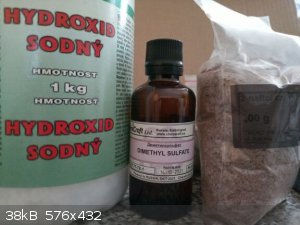
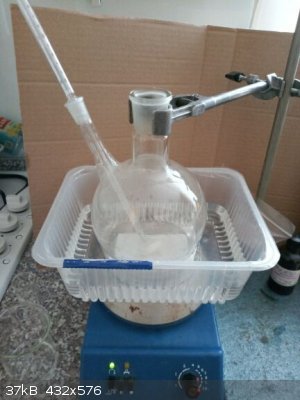
2-naphthoxide dissolved in water at elevated temperature
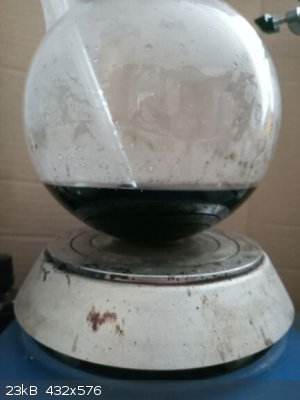
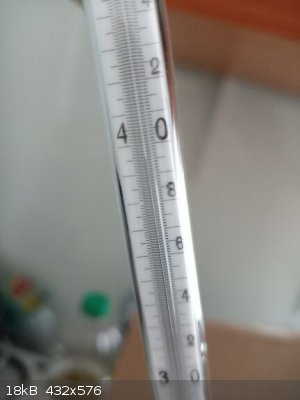
dropping funnel charged with methylating agent and a hose attached to lead toxic vapors outside of lab, when the T decreased the dropping commenced,
keeping T in range 25-35 C
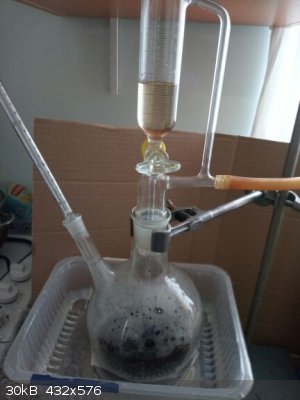
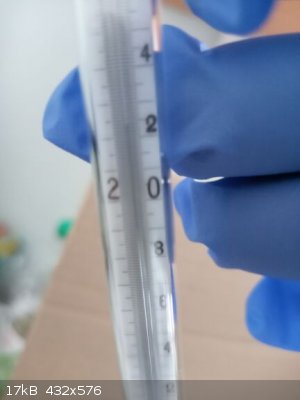
solid product appeared very soon at it was insoluble in water, the reaction became very thick so it was necessary to manually swirl the flask to break
the thick mixture
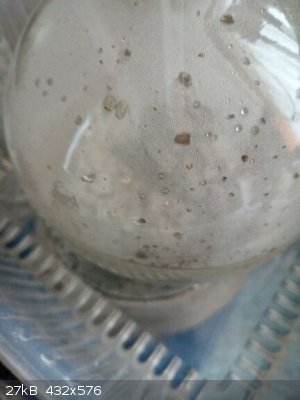
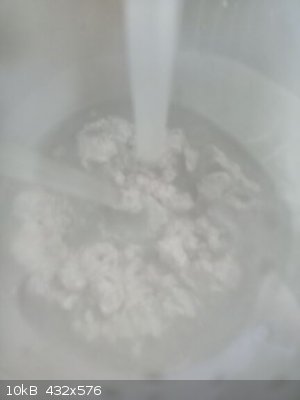
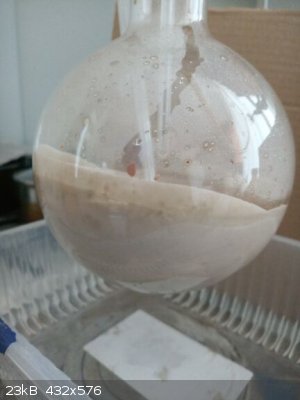
the methylation with first methyl group was fast, here a reaction mixture after heating on boiling water bath, the melted product in upper layer
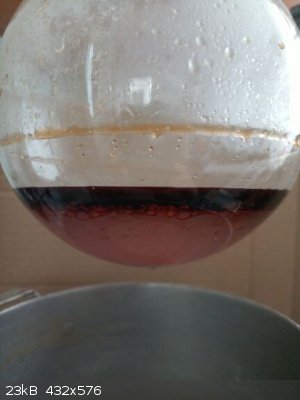
then a second methyl group of methylating agent was reacted after adding the same amount of sodium 2-naphthoxide and refluxing for 1 hour (very slow
reaction)
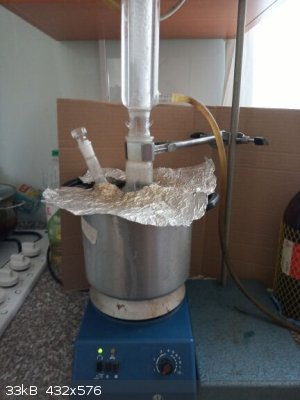
the product was hydrodistilled from the reaction to shift equilibrium towards product (very slow process, lasted 3 days with interruptions during
nights)
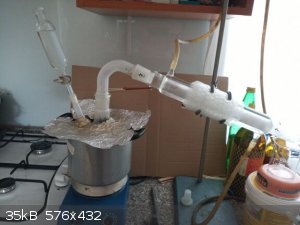
as the product is solid (m.p. 73-75 C) it could clog the condenser, so the widest inner tube condenser used, watched carefully, water circulation
stopped until product slid to the down part of the condenser... here the condensation still in the upper part as the condenser was filled with fresh
cold water
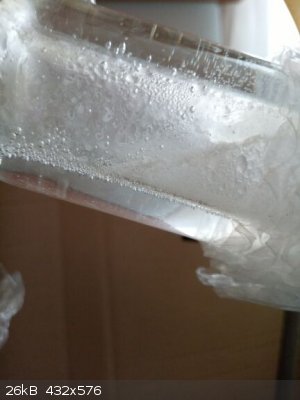
with stopped cooling water circulation the cooling water in the condenser warmed from the top to the downwards and that made the product to slid down
towards the opening of the condenser
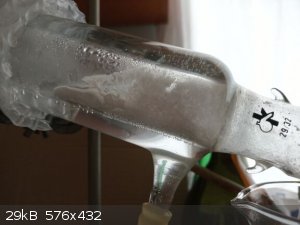
the inner tube was carefully watched through the opening of the condenser
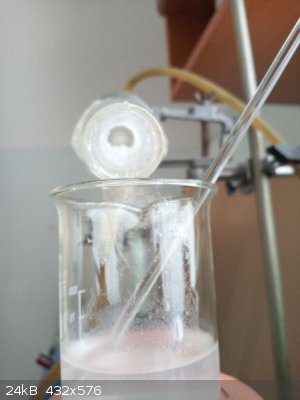
when product reached opening of the condenser, it was scraped by a glass rod into the receiving beaker and then condenser refilled with cold water by
temporarily resuming the cooling water circulation, after filling the circulation was stopped
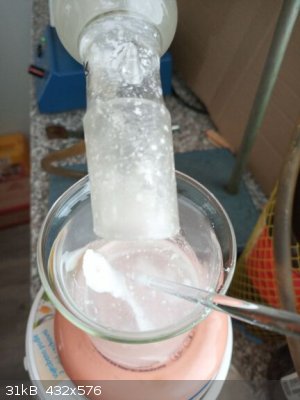
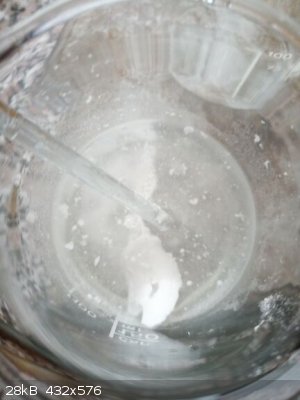
water from the distillate was gravity filtered and returned to the dropping funnel and then dropped to the distillation flask at similar rate as count
of drops from condenser
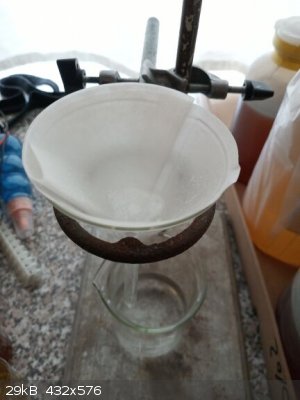
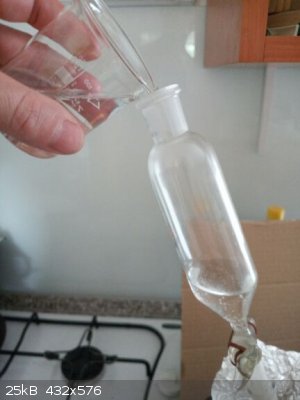
while the condenser still hot, it was easy to scrape the product and then the cooling circulation resumed to refill the condenser with cold water and
then the circulation was stopped again
maybe it could be possible to first resume cooling water circulation and only then scrape the product?
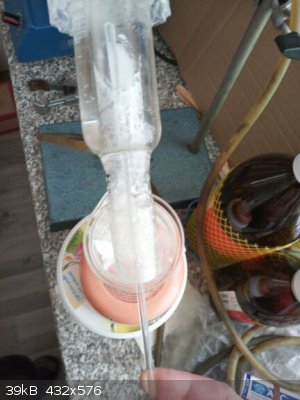
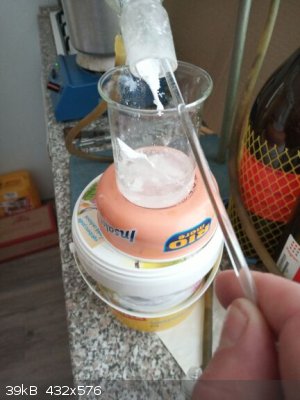
the product in a beaker after first day and finally in a dish after few days
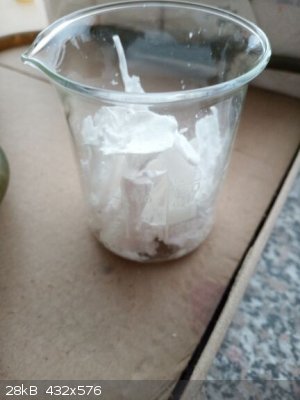
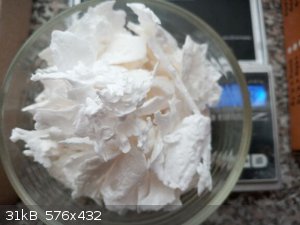
[Edited on 1-8-2022 by Fery]
Fery - 3-8-2022 at 21:04
I crystallized 4,0 g of pieces from filter paper and last portions from condenser.
It dissolved completely in 10 ml of methanol on boiling but on cooling the mass was "glued together", so I added extra 10 ml and dissolved in 20 ml of
methanol totally with a hope that from more diluted solution better crystals could be obtained.
On cooling to room temp crystallization observed and then cooled in fridge +4 C, filtered on sinter cooled in fridge, washed on sinter with 5 ml of
cold methanol (+4 C from fridge)
2,0 g of snow like white crystalline product obtained and the mother liquor was slightly discolored so some impurities passed through steam
distillation (oxidation products of 2-naphthol??? from the starting material)
Maybe hexane could produce better and larger crystals (I had success with naphthalene crystallization from isohexanes) - original procedure
crystallized it from benzene but I suppose it is well soluble in benzene due to naphthalene ring??? 2,0 g from 4,0 g using methanol is quite poor... I
discarded the mother liquor but perhaps more product could be obtained from it. Or use less methanol (4,0 g fully dissolved in 10 ml of boiling
methanol)???
m.p. 74-75 C (lit 73-75 C https://en.wikipedia.org/wiki/%CE%92-Naphthol_methyl_ether )
4,0 g dissolved in 20 ml of methanol in 50 ml FBF, here still hot before crystallization. as you see it is not colorless, some discoloration compounds
passed hydrodistillation
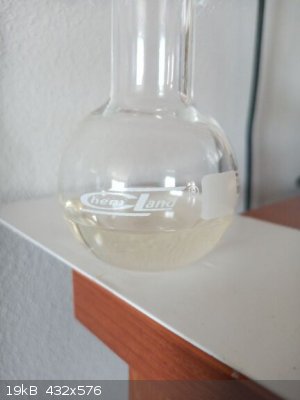
here much purer white product
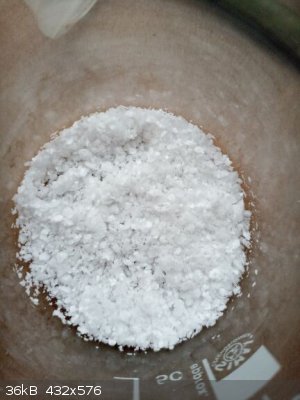
and comparison of color of product from hydrodistillation (bottom) and small amount of it after crystallization (upper)
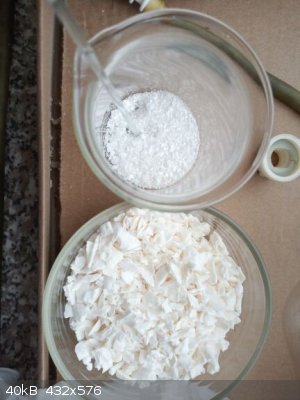
Texium - 4-8-2022 at 09:01
Such dedication keeping that distillation going for 3 days! As usual, great to see such a detailed write-up. I'm curious though, what led you to make
this compound on such a significant scale? Do you have future plans for it?
Fery - 4-8-2022 at 11:44
Hi Texium, I used magnetic stirrer with heating and oil bath, so not much powerful heating. For ethyl derivate I used much more powerful gas burner
and luckily no bumping without stirring and the hydrodistillation was done in about 8 hours. I wanted to smell these beta naphthol ethers. I would use
methyl to perfume some good soap (maybe it was already used in soaps and I have such reminiscence). Ethyl is more orange like. Both are pleasant,
decent and not too strong. I'm preparing also allyl. All 3 different routes. Methyl by dimethylsuflate (and using both methyl groups), ethyl by K2CO3
in MEK solvent + ethyliodide, allyl by beta naphthol + NaOH in isopropanol solvent and then adding allybromide into Na napthoxide (this last one is
true Williamson ether synthesis). I found that also isobutyl has good scent but I won't prepare it, these 3 by various routes are enough for me.
I had also cruel withdrawal syndrome of experimental chemistry and I was postponing these syntheses for more than 1 year.
If someone repeats this experiment, use powerful gas burner and save a lot of time!
mr_bovinejony - 23-2-2024 at 21:24
Doesn't look like you're doing this in a hood unless it's just not shown in your pictures, how'd you handle the dimethyl sulfate besides running a
tube outside? I'd like to replicate this using trimethyl phosphate but if it doesn't work I'll use dimethyl sulfate.
